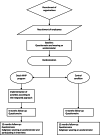A study protocol of the adaptation and evaluation by means of a cluster-RCT of an integrated workplace health promotion program based on a European good practice
- PMID: 35597983
- PMCID: PMC9123680
- DOI: 10.1186/s12889-022-13352-0
A study protocol of the adaptation and evaluation by means of a cluster-RCT of an integrated workplace health promotion program based on a European good practice
Abstract
Background: An integrated workplace health promotion program (WHPP) which targets multiple lifestyle factors at different levels (individual and organizational) is potentially more effective than a single component WHPP. The aim of this study is to describe the protocol of a study to tailor a European good practice of such an integral approach to the Dutch context and to evaluate its effectiveness and implementation.
Methods: This study consists of two components. First, the five steps of the Map of Adaptation Process (MAP) will be followed to tailor the Lombardy WHP to the Dutch context. Both the employers and employees will be actively involved in this process. Second, the effectiveness of the integrated Dutch WHPP will be evaluated in a clustered randomized controlled trial (C-RCT) with measurements at baseline, 6 months and 12 months. Clusters will be composed based on working locations or units - dependent on the organization's structure and randomization within each organization takes place after baseline measurements. Primary outcome will be a combined lifestyle score. Secondary outcomes will be the separate lifestyle behaviors targeted, stress, work-life balance, need for recovery, general health, and well-being. Simultaneously, a process evaluation will be conducted. The study population will consist of employees from multiple organizations in different industry sectors. Organizations in the intervention condition will receive the integrated Dutch WHPP during 12 months, consisting of an implementation plan and a catalogue with activities for multiple lifestyle themes on various domains: 1) screening and support; 2) information and education; 3) adjustments in the social, digital or physical environment; and 4) policy.
Discussion: The MAP approach provides an appropriate framework to systematically adapt an existing WHPP to the Dutch context, involving both employers and employees and retaining the core elements, i.e. the catalogue with evidence-based activities on multiple lifestyle themes and domains enabling an integrated approach. The following process and effect evaluation will contribute to further insight in the actual implementation and effectiveness of the integrated WHP approach.
Trial registration: NTR (trialregister.nl ), NL9526. Registered on 3 June 2021.
Keywords: Cluster randomized controlled trial; Effect evaluation; Integrated approach; Map of adaptation process; Process evaluation; Protocol; Workplace health promotion.
© 2022. The Author(s).
Conflict of interest statement
The authors declare that they have no competing interests.
Figures
Similar articles
-
The implementation of an integrated workplace health promotion program in Dutch organizations - A mixed methods process evaluation.PLoS One. 2024 Nov 1;19(11):e0308856. doi: 10.1371/journal.pone.0308856. eCollection 2024. PLoS One. 2024. PMID: 39485753 Free PMC article.
-
The Dynamic Work study: study protocol of a cluster randomized controlled trial of an occupational health intervention aimed at reducing sitting time in office workers.BMC Public Health. 2019 Feb 13;19(1):188. doi: 10.1186/s12889-019-6467-0. BMC Public Health. 2019. PMID: 30760231 Free PMC article. Clinical Trial.
-
Barriers and facilitators to the implementation of workplace health promotion programs: Employers' perceptions.Front Public Health. 2023 Jan 12;10:1035064. doi: 10.3389/fpubh.2022.1035064. eCollection 2022. Front Public Health. 2023. PMID: 36711336 Free PMC article.
-
Do worksite health promotion programs (WHPP) influence presenteeism among employees? A systematic review1.Work. 2024;77(1):85-102. doi: 10.3233/WOR-220115. Work. 2024. PMID: 37483043 Review.
-
Effectiveness of Workplace Health Promotion (WHP) interventions in university employees: a scoping review.Health Promot Int. 2023 Feb 1;38(1):daac171. doi: 10.1093/heapro/daac171. Health Promot Int. 2023. PMID: 36617296
Cited by
-
Barriers and facilitators for participation in workplace health promotion programs: results from peer-to-peer interviews among employees.Int Arch Occup Environ Health. 2023 Apr;96(3):389-400. doi: 10.1007/s00420-022-01930-z. Epub 2022 Oct 28. Int Arch Occup Environ Health. 2023. PMID: 36305914 Free PMC article.
-
Evidence-based interventions to prevent sick leave: a scoping review of reviews.BMC Public Health. 2025 Feb 24;25(1):751. doi: 10.1186/s12889-025-21911-4. BMC Public Health. 2025. PMID: 39994671 Free PMC article.
-
The implementation of an integrated workplace health promotion program in Dutch organizations - A mixed methods process evaluation.PLoS One. 2024 Nov 1;19(11):e0308856. doi: 10.1371/journal.pone.0308856. eCollection 2024. PLoS One. 2024. PMID: 39485753 Free PMC article.
-
Ergonomic risk management process for safety and health at work.Front Public Health. 2023 Nov 9;11:1253141. doi: 10.3389/fpubh.2023.1253141. eCollection 2023. Front Public Health. 2023. PMID: 38026378 Free PMC article.
-
Exploring Associations Between Device-Based Occupational Sedentary Behavior and Need for Recovery in White Collar Workers: A Compositional Data-Analysis.Int J Public Health. 2024 Jul 29;69:1607322. doi: 10.3389/ijph.2024.1607322. eCollection 2024. Int J Public Health. 2024. PMID: 39135914 Free PMC article. Clinical Trial.
References
-
- WHO . Preventing noncummunicable diseases (NCDs) by reducing environmental risk factors. Geneva: World health Organization; 2017.
-
- WHO . Noncommunicable diseases country profiles 2018. Geneva: World Health Organization; 2018.
-
- Beaglehole R, Ebrahim S, Reddy S, Voûte J, Leeder S. Prevention of chronic diseases: a call to action. Lancet. 2007;370(9605):2152–2157. - PubMed
-
- Feigin VL, Roth GA, Naghavi M, Parmar P, Krishnamurthi R, Chugh S, et al. Global burden of stroke and risk factors in 188 countries, during 1990-2013: a systematic analysis for the global burden of disease study 2013. Lancet Neurol. 2016;15(9):913–924. - PubMed
Publication types
MeSH terms
LinkOut - more resources
Full Text Sources




